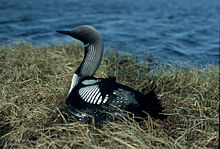Pacific divers
| Pacific divers | ||||||||||
|---|---|---|---|---|---|---|---|---|---|---|

Pacific diver ( Gavia pacifica ) |
||||||||||
| Systematics | ||||||||||
|
||||||||||
| Scientific name | ||||||||||
| Gavia pacifica | ||||||||||
| ( Lawrence , 1858) |

The Pacific diver ( Gavia pacifica ), also known as the white-necked diver , is a medium-sized species from the loons family . It occurs in Northeast Asia and the arctic and sub-arctic parts of North America.
The Pacific diver is very similar to the black-throated diver, which occasionally occurs in Central Europe during the winter half-year, and together with this species forms a superspecies . The range of these two species partially overlaps. The sympathy of both species in a significant part of their area without hybridization, although both species sometimes breed together in the same body of water, is one of the evidence that they are actually two separate species. Compared to the black-throated diver, the Pacific diver has a shorter and thinner beak and a more massive head on a short, relatively thick neck.
features
The 61 cm long Pacific diver is a small loon with a straight slender beak. Males weigh between 1500 and 2600 grams, females between 1200 and 2500 grams. In the splendid dress the head is colored light gray; The neck and back are black with white stripes and the black throat shimmers purple. In the plain dress , the entire top is monochrome black-gray. The skull, back and sides of the neck are gray; the lower sides of the head, chin, throat and front neck are sharply set off white. The gray sides of the neck are often darkly bordered towards the front. The beak is pale gray, the ridge of the beak is dark gray.
The youth dress is very similar to the plain dress, but the feathers on the upper side are more gray-brown and finely lined, so that the upper side appears clearly wavy overall. The iris is brown. The first dune dress is dark brown, the underside of the body of the chicks is somewhat lighter. The belly is gray and an indistinctly whitish ring runs around the eye. The second dune dress is similar, but a bit lighter overall. The belly is whitish.
He flies with his neck stretched out. His utterance is a high-pitched yodel-like howl.
distribution
The Pacific diver breeds on deep lakes in the tundra from Alaska to Baffin Island and south to British Columbia , Manitoba and Ontario . In Northeast Asia, the breeding area extends in a strip across the mainland stundra from the lowlands of the Jana to the east over the delta of Indigirka and Kolyma , reaches the southern border of the tundra zone in places such as the lower reaches of the Indigirka, continues over the Tschaun lowlands , which border the sea Tundra of the northern part of the Chukchi Peninsula and the catchment area Kantschalen and Tanjurer , the Anadyr area to the lowlands of the Chaturka and to the north of the Koryak Mountains. It also occurs on the Great Lyakhov Island and is a stray visitor on Wrangel Island , where it does not breed, however.
Unlike other loons, it wanders in schools. It winters on the Pacific coast or on large lakes.
Way of life
The Pacific diver feeds on fish that he catches underwater. It is sometimes associated with flocks of other seabirds such as silver and kittiwakes and rhinoceros . The two olive-brown spotted eggs are placed in a hollow in the ground, usually lined with aquatic plants, close to the water.
supporting documents
literature
- VD Il'ičev & VE Flint (eds.): Handbook of birds of the Soviet Union - Volume 1: History of exploration, Gaviiformes, Podicipediformes, Procellariiformes . Aula Verlag, Wiesbaden 1985, ISBN 3-89104-414-3
- Miklos DF Udvardy: National Audubon Society Field Guide to North American Birds - Western Region Alfred A. Knopf, New York, 1977,1994,2006 ISBN 0-679-42851-8
Web links
- Gavia pacifica in the endangered Red List species the IUCN 2008. Posted by: BirdLife International, 2008. Accessed January 31 of 2009.
Single receipts
- ↑ Il'ičev & Flint: Handbook of Birds of the Soviet Union - Volume 1: History of exploration, Gaviiformes, Podicipediformes, Procellariiformes . 1985, p. 224.
- ↑ Il'ičev & Flint: Handbook of Birds of the Soviet Union - Volume 1: History of exploration, Gaviiformes, Podicipediformes, Procellariiformes . 1985, p. 225.

